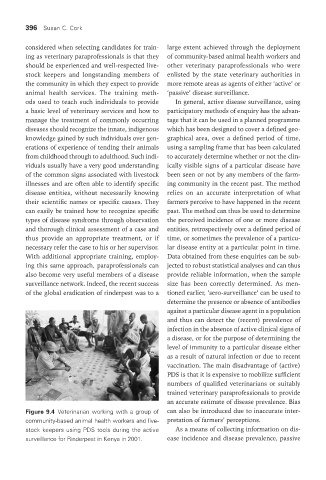Page 459 - The Veterinary Laboratory and Field Manual 3rd Edition
P. 459
396 Susan C. Cork
considered when selecting candidates for train- large extent achieved through the deployment
ing as veterinary paraprofessionals is that they of community-based animal health workers and
should be experienced and well-respected live- other veterinary paraprofessionals who were
stock keepers and longstanding members of enlisted by the state veterinary authorities in
the community in which they expect to provide more remote areas as agents of either ‘active’ or
animal health services. The training meth- ‘passive’ disease surveillance.
ods used to teach such individuals to provide In general, active disease surveillance, using
a basic level of veterinary services and how to participatory methods of enquiry has the advan-
manage the treatment of commonly occurring tage that it can be used in a planned programme
diseases should recognize the innate, indigenous which has been designed to cover a defined geo-
knowledge gained by such individuals over gen- graphical area, over a defined period of time,
erations of experience of tending their animals using a sampling frame that has been calculated
from childhood through to adulthood. Such indi- to accurately determine whether or not the clin-
viduals usually have a very good understanding ically visible signs of a particular disease have
of the common signs associated with livestock been seen or not by any members of the farm-
illnesses and are often able to identify specific ing community in the recent past. The method
disease entities, without necessarily knowing relies on an accurate interpretation of what
their scientific names or specific causes. They farmers perceive to have happened in the recent
can easily be trained how to recognize specific past. The method can thus be used to determine
types of disease syndrome through observation the perceived incidence of one or more disease
and thorough clinical assessment of a case and entities, retrospectively over a defined period of
thus provide an appropriate treatment, or if time, or sometimes the prevalence of a particu-
necessary refer the case to his or her supervisor. lar disease entity at a particular point in time.
With additional appropriate training, employ- Data obtained from these enquiries can be sub-
ing this same approach, paraprofessionals can jected to robust statistical analyses and can thus
also become very useful members of a disease provide reliable information, when the sample
surveillance network. Indeed, the recent success size has been correctly determined. As men-
of the global eradication of rinderpest was to a tioned earlier, ‘sero-surveillance’ can be used to
determine the presence or absence of antibodies
against a particular disease agent in a population
and thus can detect the (recent) prevalence of
infection in the absence of active clinical signs of
a disease, or for the purpose of determining the
level of immunity to a particular disease either
as a result of natural infection or due to recent
vaccination. The main disadvantage of (active)
PDS is that it is expensive to mobilize sufficient
numbers of qualified veterinarians or suitably
trained veterinary paraprofessionals to provide
an accurate estimate of disease prevalence. Bias
Figure 9.4 Veterinarian working with a group of can also be introduced due to inaccurate inter-
community-based animal health workers and live- pretation of farmers’ perceptions.
stock keepers using PDS tools during the active As a means of collecting information on dis-
surveillance for Rinderpest in Kenya in 2001. ease incidence and disease prevalence, passive
Vet Lab.indb 396 26/03/2019 10:26

